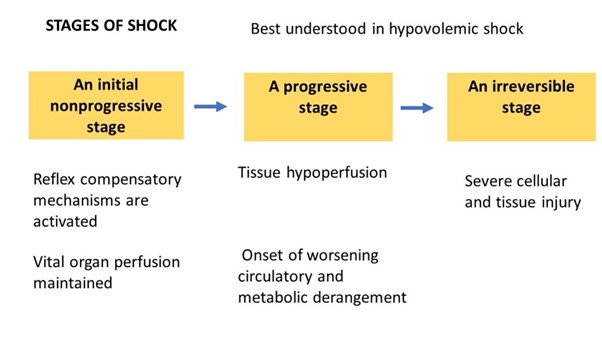What typical sign/symptom indicates the early stage of septic shock?
Tachypnoea and tachycardia
Pallor and cool skin
Blood pressure 84/50 mm Hg
Respiratory acidosis
The Correct Answer is A
In the early stage of septic shock, the body initiates compensatory mechanisms to combat the infection and restore adequate tissue perfusion. Tachypnoea (rapid breathing) and tachycardia (elevated heart rate) are common early signs of septic shock.
Tachypnoea occurs as a response to increased metabolic demand and to compensate for impaired oxygenation and tissue perfusion. Tachycardia is the body's attempt to maintain cardiac output and compensate for decreased blood pressure.
B. Pallor and cool skin in (option B) is incorrect because Pallor and cool skin can occur in later stages of septic shock when perfusion to the peripheral tissues is compromised. However, they are not specific to the early stage.
C. Blood pressure 84/50 mm Hg in (option C) is incorrect because A blood pressure reading of 84/50 mm Hg indicates hypotension, which is typically seen in later stages of septic shock. In the early stage, blood pressure may still be within normal or slightly decreased range.
D. Respiratory acidosis in (optionD) is incorrect because: Respiratory acidosis refers to an imbalance in acid-base status and is not specific to the early stage of septic shock. Acid-base disturbances may occur at any stage of shock but are not indicative of the early stage.

Nursing Test Bank
Naxlex Comprehensive Predictor Exams
Related Questions
Correct Answer is ["18"]
Explanation
Step 1: Convert the patient's weight from pounds to kilograms. 130 pounds ÷ 2.205 (1 pound = 0.453592 kilograms) ≈ 58.97 kilograms
Step 2: Calculate the total dosage of Dobutamine required per hour based on the weight-specific dose. 2.5 mcg/kg/min × 58.97 kg = 147.425 mcg/min
Step 3: Calculate the infusion rate (mL/hr) using the concentration of Dobutamine in the prepared solution. The solution contains 250 mg of Dobutamine in 500 mL, which means there are 250,000 mcg of Dobutamine in 500 mL. To determine the mL/hr, divide the required dosage (147.425 mcg/min) by the amount of Dobutamine in 500 mL (250,000 mcg) and multiply by 500 mL (volume of the solution).
(147.425 mcg/min ÷ 250,000 mcg) × 500 mL ≈ 0.295 mL/min
To get the mL/hr, we convert the rate from minutes to hours (60 minutes = 1 hour):
0.295 mL/min × 60 min/hr ≈ 17.7 mL/hr
Round the answer to the nearest whole number:
Approximately 18 mL/hr of Dobutamine should be administered to the patient.
Correct Answer is B
Explanation
Assessing the patient's level of consciousness is a critical initial step in evaluating a patient with shock. Altered mental status or decreased level of consciousness can be indicative of inadequate cerebral perfusion and may require immediate interventions to address compromised brain function and ensure patient safety.
While all the options mentioned are important in the assessment and management of a patient in shock, checking the level of consciousness takes priority as it provides essential information about the patient's neurological status and helps guide further interventions.
A. Obtaining the blood pressure in (option A) is incorrect because Assessing blood pressure is crucial in evaluating a patient in shock, but it can be done in conjunction with checking the level of consciousness and other vital signs.
C. Administering oxygen in (option C) is incorrect because: Administering oxygen is important in managing shock, as tissue hypoxia is a key concern. However, it can be done simultaneously with assessing the level of consciousness and initiating other interventions.
D. Obtaining a 12-lead electrocardiogram (ECG) in (option D) is incorrect because While an ECG may provide valuable information about the patient's cardiac function, it is not the first priority in a patient with shock of unknown etiology. Assessing the level of consciousness and vital signs takes precedence.
Whether you are a student looking to ace your exams or a practicing nurse seeking to enhance your expertise , our nursing education contents will empower you with the confidence and competence to make a difference in the lives of patients and become a respected leader in the healthcare field.
Visit Naxlex, invest in your future and unlock endless possibilities with our unparalleled nursing education contents today
Report Wrong Answer on the Current Question
Do you disagree with the answer? If yes, what is your expected answer? Explain.
Kindly be descriptive with the issue you are facing.
